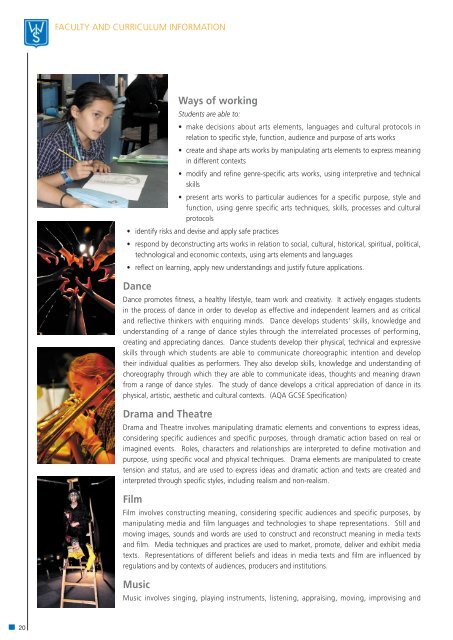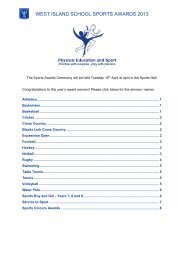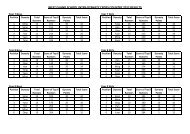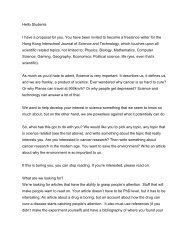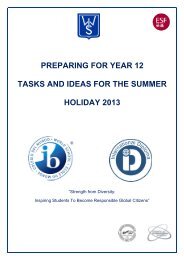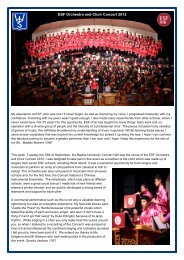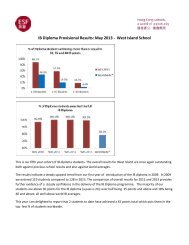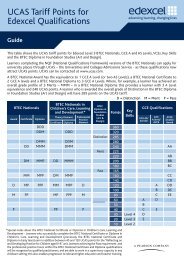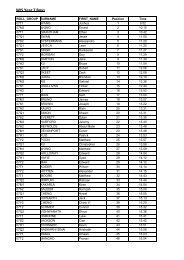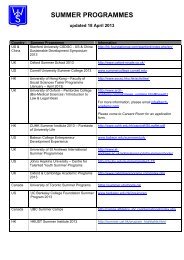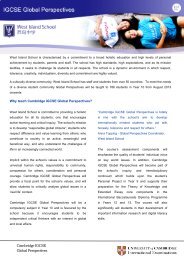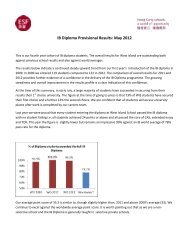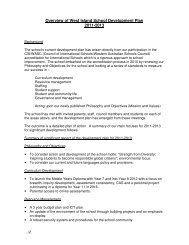WIS Prospectus 2012 - West Island School New Portal
WIS Prospectus 2012 - West Island School New Portal
WIS Prospectus 2012 - West Island School New Portal
You also want an ePaper? Increase the reach of your titles
YUMPU automatically turns print PDFs into web optimized ePapers that Google loves.
FACULTY AND CURRICULUM INFORMATION<br />
Ways of working<br />
Students are able to:<br />
• make decisions about arts elements, languages and cultural protocols in<br />
relation to specific style, function, audience and purpose of arts works<br />
• create and shape arts works by manipulating arts elements to express meaning<br />
in different contexts<br />
• modify and refine genre-specific arts works, using interpretive and technical<br />
skills<br />
• present arts works to particular audiences for a specific purpose, style and<br />
function, using genre specific arts techniques, skills, processes and cultural<br />
protocols<br />
• identify risks and devise and apply safe practices<br />
• respond by deconstructing arts works in relation to social, cultural, historical, spiritual, political,<br />
technological and economic contexts, using arts elements and languages<br />
• reflect on learning, apply new understandings and justify future applications.<br />
Dance<br />
Dance promotes fitness, a healthy lifestyle, team work and creativity. It actively engages students<br />
in the process of dance in order to develop as effective and independent learners and as critical<br />
and reflective thinkers with enquiring minds. Dance develops students' skills, knowledge and<br />
understanding of a range of dance styles through the interrelated processes of performing,<br />
creating and appreciating dances. Dance students develop their physical, technical and expressive<br />
skills through which students are able to communicate choreographic intention and develop<br />
their individual qualities as performers. They also develop skills, knowledge and understanding of<br />
choreography through which they are able to communicate ideas, thoughts and meaning drawn<br />
from a range of dance styles. The study of dance develops a critical appreciation of dance in its<br />
physical, artistic, aesthetic and cultural contexts. (AQA GCSE Specification)<br />
Drama and Theatre<br />
Drama and Theatre involves manipulating dramatic elements and conventions to express ideas,<br />
considering specific audiences and specific purposes, through dramatic action based on real or<br />
imagined events. Roles, characters and relationships are interpreted to define motivation and<br />
purpose, using specific vocal and physical techniques. Drama elements are manipulated to create<br />
tension and status, and are used to express ideas and dramatic action and texts are created and<br />
interpreted through specific styles, including realism and non-realism.<br />
Film<br />
Film involves constructing meaning, considering specific audiences and specific purposes, by<br />
manipulating media and film languages and technologies to shape representations. Still and<br />
moving images, sounds and words are used to construct and reconstruct meaning in media texts<br />
and film. Media techniques and practices are used to market, promote, deliver and exhibit media<br />
texts. Representations of different beliefs and ideas in media texts and film are influenced by<br />
regulations and by contexts of audiences, producers and institutions.<br />
Music<br />
Music involves singing, playing instruments, listening, appraising, moving, improvising and<br />
20


